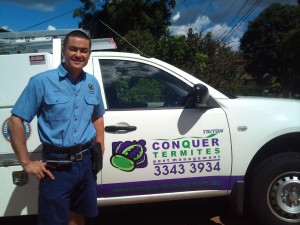
When termites are feeding on a wooden structure they will leave a thin layer of wood undisturbed on the outside to conceal and protect themselves from the environment.
Due to their ability to leave the outer timber undisturbed for a long time while they tunnel through and eat the inner parts, the problem is often only discovered when the timbers are already severely damaged.
One of the earliest signs of termite damage is a papery, hollow sounding part of the infected timber. It is important to identify this as soon as possible to prevent further damage.
Termites produce a lot of moisture as they feed and tunnel, causing the wood to warp and deform.
When wood is damp it will swell as it absorbs the moisture. Because termites produce an uneven distribution of moisture in the wood as they tunnel and feed, they cause one part of the wood to swell while others remain dry, causing warping and damage.
One way to identify swollen and deformed timbers is tight fitting doors and hard to open windows.
When termites are tunnelling and feeding they can be quite loud. This can be identified by putting your ear up to the wall or using listening equipment and knocking on the wood to prompt a noisy termite reaction.
Due to their ability to leave the outer timber undisturbed for a long time while they tunnel through and eat the inner parts, the problem is often only discovered when the timbers are already severely damaged.
One of the earliest signs of termite damage is a papery, hollow sounding part of the infected timber. It is important to identify this as soon as possible to prevent further damage.
Flying termites, also known as termite alates, are termites searching for a place to establish a new colony. This is an important seasonal process performed by most termite species called nuptial flight.
The colony will produce both male and female flying alates, whose purpose is to find a new colony location and then breed. Some species of termite will do this at night, and the alates will be attracted to light. Termite colonies will often produce alates immediately after rain at certain times of the year.
Termite droppings, also known as frass, is the feces and refuse produced by termites as they feed. As termites consume wood, they create small holes in the outer layer of the timber that they use to push out their waste.
The presence of frass is usually indicated by small brown pellets that have been discarded nearby the infected timber.
For more information or professional advice on termites in the South Brisbane area, contact Conquer Termites South Central today.
Online Enquiry 0432 721 715
Professional Pest/Termite Inspection, Termite Treatment and Pest Control Services in Coopers Plains, Robertson, Acacia Ridge, Sunnybank, Kuraby, Eight Mile Plains and surrounding Suburbs.
0432 721 715
nick@conquertermites.com.au
Office 12, Building 6, 18 Torbey St, Sunnybank Hills, 4109